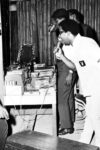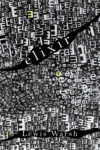
Photo Credit: Peter Frank Edwards
The Minus Times started in 1992 as, in the words of Hunter Kennedy, “a one-page open letter crammed with stories and news clippings as well as occasional dispatches from the far corners of America.” He would leave copies in the doorways of Austin businesses and from there a community or readers and contributors slowly grew. The principles are there right from the start — pages crammed with miscellany, lists, short fiction, dispatches from different realities —, really a repository for the excess creativity that the far corners of America generate in the right kind of mind.
It is hard to overstate how consistently funny and interesting The Minus Times Collected is, how great it is to have all 30 issues in one place. You have Harmony Korine asking David Berman who he would kill, and who he would resurrect if made to (Neil Boortz & Brian Billick would be killed, Noah resurrected). You have Dave Eggers’ studies for Donald Barthelmes’s Forty Stories, alongside the amazing cartoons and illustrations of Brad Neely and Harrison Haynes. You have ads for reasonably priced compound bows and personals with the strong open of “Achtung Frauleins!”
Behind the whole enterprise is Hunter Kennedy, currently the principle designer at Kennedy Design Studios in Charleston, South Carolina. Over email I asked Hunter about working at the margins of culture, his college days with Pavement, the Silver Jews, and Dave Matthews, and whether having a day job may be a benefit to the writer’s life.
Michael Schapira: Drag City, as Patrick DeWitt talked about in his Introduction to the collection, is a place that many people felt “a kinship with and admiration for.” There are lots of other places that sprung up around the time you started doing The Minus Times and after — K Records in Olympia, which as a college student in Oregon was the first label I felt this strong identification with, but also Dischord in DC, Goner in Memphis, Merge in Chapel Hill, I could go on. When Drag City contacted you with their interest to put out The Minus Times were you aware of any of these other labels working on building a print operation, and did the whole mission of building a press attached to a label make sense to you then?
Hunter Kennedey: Launching the magazine with Drag City made perfect sense in 1996. They had a very targeted distribution network of independent record stores and a discriminating following that were just as interested in good writing. It was a good match because Drag City already made its living taking risks and encouraged me to do the same.
You called the early distribution method, just leaving stacks of the broadsheet in Austin doorways, as “a running experiment in chance.” Parts of The Minus Times, especially the reconstructed newspaper articles, remind me of Mark Flood’s music project Culturcide, which started in Texas a few years earlier. If Mark Flood had the idea of killing culture, what was your relationship to culture or, say, other forms of printed matter at the time?
My relationship to culture? An outlier. Prior to starting the MT, I was too young to be taken seriously by literary flagships like the Paris Review or the New Yorker, and I was disinterested in corporate culture beyond the most absurd iterations. So I spent my time on the margins, which were much less porous and more opaque than they are today. The clippings from the MT reflect the four years I spent in Texas, five more in a Polish outpost in Brooklyn more popularly known as Williamsburg, and the last dozen or so here in the Republic of South Carolina, where I was born. Most of the clippings came from SC, with TX a close second.
David Berman described the early years of The Minus Times as exploring the “the aesthetic of brutal incompetence.” Is this a fair description of those first editions and have you ever moved past it?
The comment refers to my distribution method, which was haphazard and arbitrary. David gave me too much credit for the planning of this exploration. It never reached the level of “aesthetic.” That’s like a craps shooter talking about his “skill” with dice. I was just hoping to get lucky.
This is several years back, but Drag City published one of my favorite books ever written by a musician, John Fahey’s How Bluegrass Music Destroyed My Life. Do you have favorite books written by musicians, or books that made you think that writing is part of their full compliment as an artist?
I don’t believe someone talented in one area is necessarily talented in all, but there are exceptions. You forgot to mention David Berman’s Actual Air. Or maybe that was too obvious. The other multi-disciplinary examples that come to mind seem to be by photographers (The Daybooks of Edward Weston), and Brassai’s Henry Miller: The Paris Years, and one of my favorite filmmakers (Bunuel’s My Last Sigh).
Anyone who picks up this collection might be surprised to find names that have made their way into the mainstream, like Steven Colbert, Dave Eggers, or even Sam Lipsyte, but seeing Bob Nastanovich writing a recap of his 1996 season betting on thoroughbreds was far more exciting to me in seeing how someone who might be fairly well-known would embrace the spirit of the journal. As more people became involved did you get suggestions from musician friends along of the lines of “you need to talk to Bob, he’s pretty successful at the tracks” or “you should talk to Will [Oldham] if you want an encyclopedic response to a simple question about movies?”
I didn’t solicit much outside advice when it came to contributors — for better or worse — but I was lucky to have some talented friends willing to pitch in. Bob Nastanovich and I had known each other since we met in Charlottesville in 1988, and he introduced me to Will Oldham the night before the 1992 Kentucky Derby. I first knew him as the kid who was in Matewan, which if you haven’t seen it is an excellent film by John Sayles. Film picks seemed like a natural fit for him. Sam Beam later contributed his own movie suggestions. I knew he’d taught film at a college in Florida before ditching academia for Iron & Wine.
You knew Bob Nastonovic and David Berman from back in your college days in Charlottesville, Virginia. Was there something at that time that made it a hub for all these creative people? UVA seems to have changed a lot in the subsequent decades and I wonder if the conditions for cultural vibrancy have changed as well.
Some towns have their moments, and the late eighties / early nineties was a great time to be in Charlottesville. You had Pavement and the Silver Jews come out of there, but you also had Dave Matthews playing gigs every Tuesday night at Trax. The first time I went to see him play, right as we were walking in the door, his sister Jane said he was going to buy her a car when he made it big. I said she’d be waiting for that car a long time. Turned out it was about a year. Point being that only in hindsight did I really begin to appreciate that moment for what it was. I thought it had more twisted eccentrics per square inch than Austin or New York. Where else are you going to be accosted by William Burroughs’ pint-sized bibliographer? (That happened.)
I could talk more about the links with musicians, but my favorite part of seeing the collection was the images — the amazing cartoons of Brad Neely and illustrations of David Berman, the marginalia culled from advertisements or encyclopedias, the reconstructed newspaper clippings. Those are there right from the start and continue as the journal grows (and they are consistently some of the funniest things I have ever seen on the printed page). Why, as someone who wanted to write, did you get so interested in giving the journal this distinct look?
I’ve always enjoyed making collages. All you need are a discarded newspaper, scissors and glue. Since every issue was cut and pasted together on typed pages, and I handled all of the layouts, even to the point of designing ads, it played to one of my strengths. If it had been necessary to lay out this magazine on a computer, we might not be having this conversation. But the fact that there’s so little about this publication that’s digital just makes it more subversive by the year.
The Minus Times seems essentially southern to me in its sensibility (and particularly in its sense of humor). Does this mean anything to you?
That’s a fair assessment, even though it’s never been exclusively southern. It’s just a reflection of the editor’s tastes, and that of the writers who were motivated to contribute after reading those first issues. I don’t know of any other underground southern literary magazines out there, so if the MT can fill that breach, then so be it.
There is a unique sense of humor where I grew up. You can’t take yourself too seriously, and you understand the nuances of sarcasm. Folks in California are much more literal, so they have a hard time understanding what you mean if you say, “I can’t wait,” when really you could wait until hell freezes over. It also goes without saying that we have a taste for the absurd. God bless Barry Hannah and John Kennedy Toole.
Where is the strangest place you ever saw a copy turn up?
The strangest place I’ve ever heard of a copy turning up was from my former web designer, who’s now a well traveled documentary photographer. She spotted the MT Collected at her favorite bookstore in Istanbul. That was unexpected.
I’ve gotten a lot of letters over the years about how people have found the magazine. It usually involves some form of serendipity. But the kind of reader who really embraces this project is somebody who is open to the world and its strange possibilities.
Did you see Boyhood? In issue 28 you have a story called “Running with the Assassins” about an assassination plot hatched by two people who may resemble members of Sonic Youth against Ethan Hawke for his “crimes against our generation,” specifically his popularization of the goatee and his self-involved portrayal in Reality Bites. Do you, if you share the views of the would-be assassins, still harbor any enmity towards Linklater and Hawke?
I didn’t share my friends’ opinion on the use of assassinating Ethan Hawke, when Hollywood churns out young male leads with the speed and efficiency of an electric composter. So kudos to Hawke and Linklater for taking on such an ambitious film project, which I genuinely look forward to seeing. Actors are only as good as the script they are given. A child aging in real time beats a 30 million dollar package of special effects, hands down.
By the way, Linklater is one of the reasons I moved to Austin in the first place. I’d never heard of the place before watching Slacker. I went back not that long ago and was surprised by how much it had changed. The musicians are dead broke and literally singing for their supper while the tech posse throws hundred thousand dollar birthday parties down by the lake. I’m sure a few of them are on somebody’s shit list.
If someone picked up The Minus Times Collected for the first time, and saw the range of contributors, they’d probably expect that you’ve been working this whole time as a writer, musician, artist, or someone in the Drag City orbit. But your job for some time now has been running a residential design firm in Charleston. It’s surely a false choice, and there are so many examples from Kafka to Wallace Stevens of writers who had day jobs, but many young people today feel it’s impossible to lead a life dedicated to creative pursuits and seek conventional employment. Can you talk some reason into these hypothetical frustrated artists, or have you felt a tension between your design work and your writing and editing?
I understand your surprise at how I make a living, but I disagree with your assessment that it was a false choice. It was a necessity. I’d say the real false choice is writing crap that will sell by the ream just so you can continue to be a full-time novelist. Having a job alleviates that pressure to publish quickly, and having an office gives me a quiet place to write. If somebody came along and offered me a stipend to write full-time, I would gladly do so. In the meantime, I’ve still got to pay the light bill. The best advice I can give those aspiring writers out there is to have a backup plan.
The other thought that I wanted to add was the advantage I find in working: material for my writing. There’s never a dull moment in the world of construction. If shit can go wrong, it will, and often spectacularly.
What is the status of the Minus Times?
It’s fair to say that the Minus Times is an ongoing project, but the editor is on sabbatical to finish a novel. I figured after twenty years I’d earned a break.
Michael Schapira is the Interviews Editor for Full Stop.
This post may contain affiliate links.







